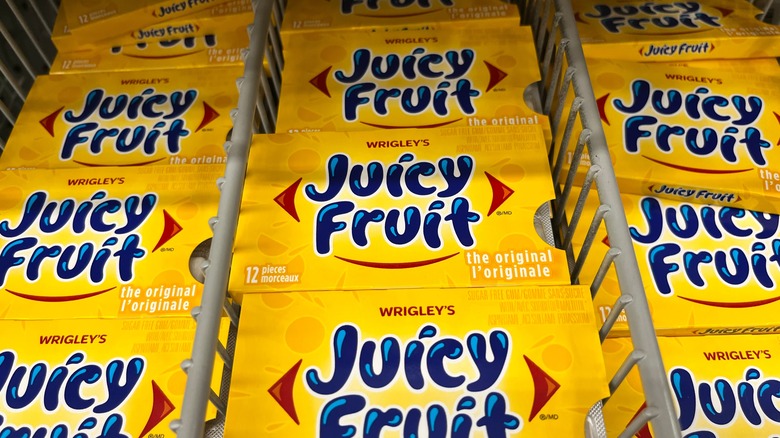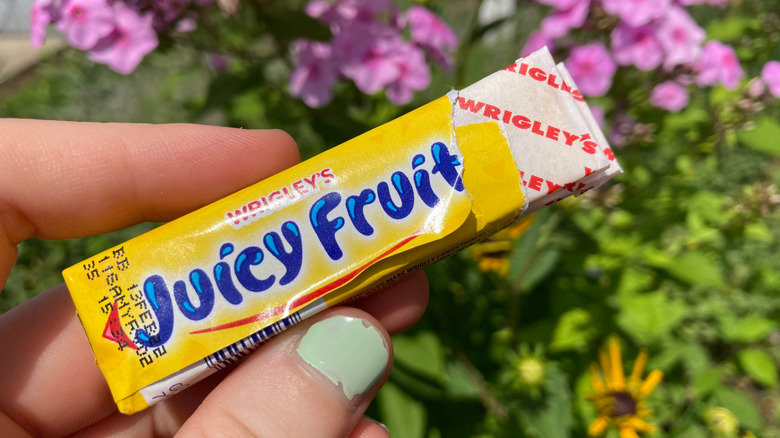Juicy Fruit Gum Existed During The Gilded Age
Raise your hand if your first memory of Juicy Fruit gum is a TV commercial. We thought so. Juicy Fruit likely makes you think of smiling actors popping a stick of gum into their mouths before weightlifting, dirt-biking, or displaying telekinetic powers (that commercial featured Aaron Paul from "Breaking Bad," just so you know). If you're old enough, you also remember the catchy jingle: "The taste is gonna move ya." So, given this iconic chewing gum's close associations with snappy TV marketing, you'd be forgiven for assuming Juicy Fruit is a newer invention originating sometime in the late 20th century. The thing is, you'd be so, so wrong.
The world's first chewers of Juicy Fruit gum were neither hippies nor Madonna fans, and they certainly didn't have frosted tipped-hair or listen to NSYNC. Picture that gum 100 years or so earlier in the hands of women with long, wasp-waisted dresses, their hair piled high atop their heads, or guys in three-piece suits and bowler hats. Specifically, imagine 1893, the end of the Gilded Age. Yes, that's when Juicy Fruit came out. It's the oldest Wrigley brand, and it has a history as fascinating as it is long.
The early days of Wrigley's Juicy Fruit gum
William Wrigley Jr. started in the soap and baking soda business with today's equivalent of $919.85 to his name. A savvy marketer, he used chewing gum as bait to coax customers into his store. But seeing that his patrons were more interested in the bait than the other goods, he set to work producing and marketing his first two gum brands: Lotta Gum and Vasser. Eventually, he developed a recipe called Juicy Fruit, which made its grand debut at the Chicago World's Columbian Exposition of 1893.
It took some 21 years after Juicy Fruit's introduction for it to taste anything like the gum we know today. When it first came out in the Gilded Age, Juicy Fruit featured a conventional minty flavor. Sometime around 1914, however, Wrigley's chemist Walter E. Diemer discovered a beguiling fruity concoction of synthetic flavorings while he was playing around with recipes. The gum's mintiness was soon replaced with a trademark fruity taste that won Juicy Fruit a mighty fanbase. The exact flavor of Juicy Fruit gum is something of a mystery. But in 2002, in response to a letter from a curious gum chewer, the company stated that although the exact formula is proprietary, Juicy Fruit Gum contains heavy notes of lemon, orange, pineapple, and banana.
Juicy Fruit from mid-century to today
With its eye-catching yellow package and distinct flavor, Juicy Fruit's popularity was climbing. It was unique among gums, and quality was one of its defining characteristics. Quality was so vital to the Wrigley brand, in fact, that a shortage of good ingredients during World War II prompted the company to temporarily withdraw Juicy Fruit and Doublemint from the civilian market, dispensing them only to the U.S. Armed Forces. Civilians still got Orbit gum during the rationing, though Wrigley was transparent about substituting inferior ingredients into the product. (Orbit gum already existed, by the way. It wasn't a food that resulted out of wartime.)
Continuing to expand on the gum's success, Wrigley would go on to introduce other versions of the iconic treat, from sugar-free to flavor combinations, and consumers chewed it up. When synthetic rubber became more affordable in the 1960s (yes, rubber — that's how bubble gum is made), the altering of the gum's composition seemed to have no ill effect on sales. In due course, Wrigley became the world's most successful and recognized manufacturer of chewing gum.
By the time the "It's gonna move ya" jingle appeared in those TV commercials in 1986, William Wrigley Jr. had been gone for over 50 years. Being the marketing guru that he was, though, he would have loved it. It was iconic, and it left a really good taste in the public's mouth that lingers even today — not a minty taste, mind you; a Juicy Fruit one.


